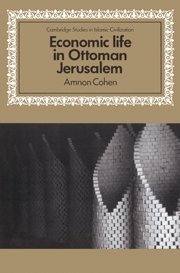Book contents
- Frontmatter
- Contents
- List of illustrations
- Note on transcription
- Map1
- Introduction
- 1 Butchers and meat consumption
- 2 Soap production and olive oil
- 3 Flour and bread
- Conclusion
- Note on abbreviations
- Note on weights, measures and monetary values
- Appendix 1 Meat prices in Jerusalem
- Appendix 2 Olive oil and soap prices in Jerusalem
- Appendix 3 Flour and bread prices in Jerusalem
- Appendix 4 A soap-factory in Jerusalem
- Notes
- Bibliography
- Subject index
- Geographical index
- Index of personal names
Appendix 4 - A soap-factory in Jerusalem
Published online by Cambridge University Press: 10 November 2010
- Frontmatter
- Contents
- List of illustrations
- Note on transcription
- Map1
- Introduction
- 1 Butchers and meat consumption
- 2 Soap production and olive oil
- 3 Flour and bread
- Conclusion
- Note on abbreviations
- Note on weights, measures and monetary values
- Appendix 1 Meat prices in Jerusalem
- Appendix 2 Olive oil and soap prices in Jerusalem
- Appendix 3 Flour and bread prices in Jerusalem
- Appendix 4 A soap-factory in Jerusalem
- Notes
- Bibliography
- Subject index
- Geographical index
- Index of personal names
Summary
The flourishing soap-making industry in sixteenth-century Jerusalem underwent a gradual decline until, during the late Ottoman period, it ground to a halt. Unlike Nablus, where Ottoman soap-factories are still operational today, hardly any remnants of maṣbanas can be identified in present-day Jerusalem.
Any extant vestiges should naturally be sought in the quarter known as the Khan al-Zayt (olive oil marketplace) south of Damascus gate. Shaykh Asʿad al-'Imām, an authority on local history and a scholar in his own right, was kind enough to help us locate the only remains of a maṣbana still to be found in Jerusalem. House Number 37 in Khān al-Zayt belongs to the al-Quṭayna family, known in the nineteenth century for their intensive involvement in the production of oil as well as soap. Part of the building is used as their residence; the rest is derelict but extremely impressive from our standpoint.
The second storey is a huge hall, 29 × 16.40 meters. It had at least 20 stone pillars supporting the arches on which the roof rested. (Cf: sijill, vol. 77, pp. 340–1, describing another soap-factory in Jerusalem introduced in the late sixteenth century into an old building, where the roof rests on 24 pillars and 30 arches.) The pillars are 145 × 125 cm. each, rising at the highest point of the arch to 3.30 meters.
- Type
- Chapter
- Information
- Economic Life in Ottoman Jerusalem , pp. 152Publisher: Cambridge University PressPrint publication year: 1989

